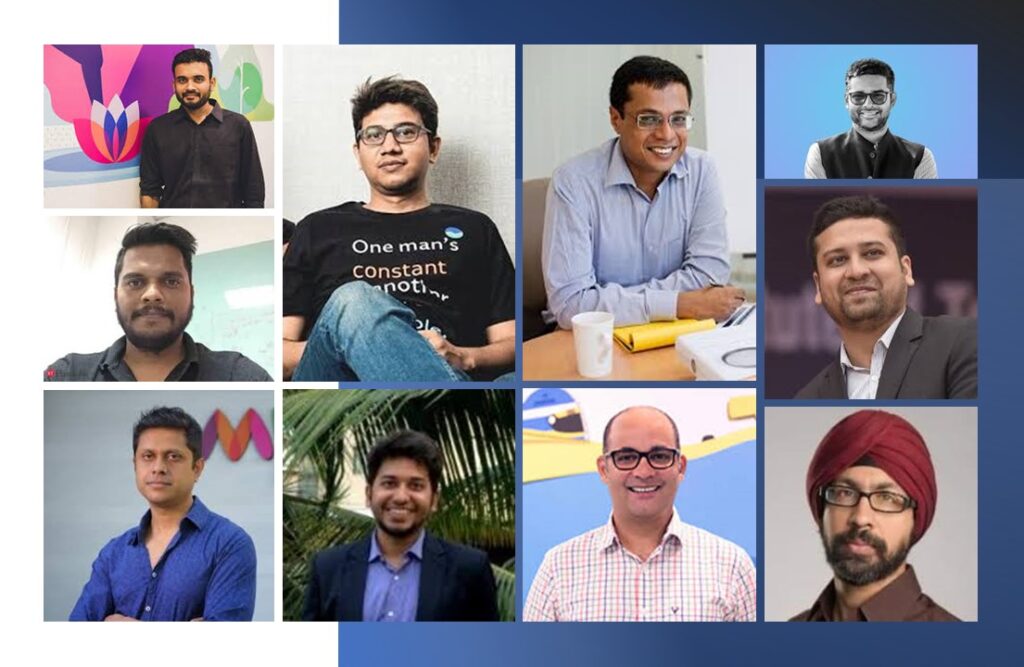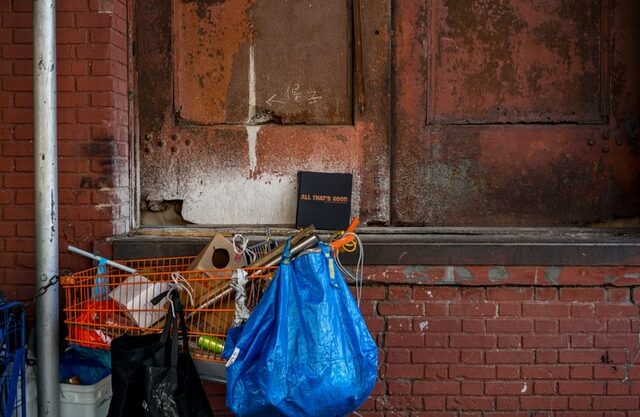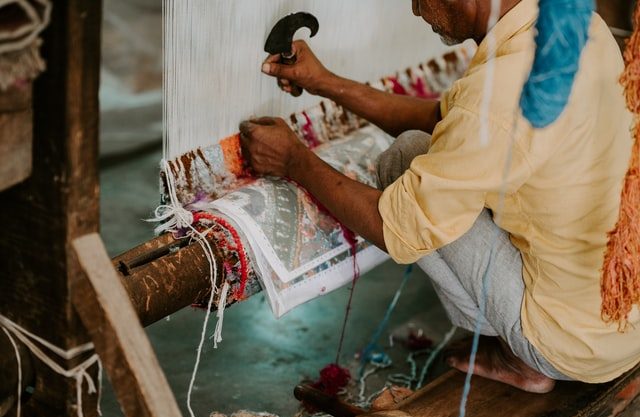During British rule, Indian handloom weavers and artisans were crushed under heavy taxes and the advent of mechanization of textile mills. This was a blow to the widespread and continuing handloom tradition, which supplied various fabrics to all classes of customers.
Post-Independence, Gandhi’s Nationalist Khadi movement did revive the handloom and textile industry. However, with industrialization and power looms, cheap and convenient cloth became the norm of the working class. This caused the weaver population to diminish significantly, forcing them to change their professions as peanut-sellers, rickshaw-pullers, etc.
India’s varied textile and artisan heritage was lost.
In 1958, a Yale graduate and an American Consultant working for the Ford Foundation in India was about to change the fate of Indian weavers and artisans in the years to come.
John Bissell was in awe of the potential rural India had for handloom textiles, and the skills artisans garnered over the years, passed down from generation to generation. At the end of his 2-year grant, John decided to stay back and establish his own export company Fabindia – ‘the fabric of India’ in 1960. John traveled across villages and towns, meeting weavers and small-scale entrepreneurs -who produced flatweaves and multi-colored cloth in handloom yardages.
Fabindia started as an Export business at John’s home in New Delhi, exporting furnished goods and subsequently hand-woven fabric to customers overseas. John also established a twin company in Connecticut, the USA, as ‘Fabindia Inc.,’ which created a distribution network, selling to mom-and-pop American stores.
By 1965, Fabindia’s turnover exceeded 2 Million INR.
Business Model brought Rapid growth for Fabindia but with a warning
Fabindia would sell furnished goods under other brand names abroad until 1976 when it opened up its first retail store in Greater Kailash, New Delhi. Selling mainly leftover supplies from previous export orders under its own brand name.
Fabindia procured directly from rural artisans without any middlemen, causing them to have higher profit margins than their competitors. Its relationship with Habitat, a UK-based retailer as a major customer, contributed to 60-65% of the revenue for 28 years overseas. Its relationship with Bharat Carpet Manufacturers (BCM) as a Supplier of ‘Durries’ (hand-knotted rugs and mats) proved to be the driving force of John’s business.
Fabindia’s revenue and popularity grew exponentially over the years. Demand for its authentic fabrics increased, causing supply chain issues. Creating those hand-woven fabrics took time and patience (a quality that customers tend to lack). John Bissell realized that increasing sales volume and expanding further would be a humungous task and instead decided to focus on quality control instead of rapid expansion.
After considerable thought, I have come to the conclusion that Fabindia in India is a pretty good size. We shouldn’t push for growth – as this means taking on orders and customers without much discretion…. Besides I think this is our ‘role’– find, develop, and then when a new fabric or durrie gets to be popular and demanded in great volume, let others pick it up… and go on to something new.
John Bissell, 1980 in book Fabric of our Lives
A new Heir, A Blessed Strategy
In 1998, John Bissell passed away, letting his son William Bissell take over the reins. William had a modern outlook for Fabindia. He identified that the sun was setting on the export business model of Fabindia. He did not want to “work like a dog and produce something under someone else’s label.”
Hence Fabindia started setting up retail stores all over the country. There are 322 stores all over India, 2 stores each in Singapore and Dubai, and 1 each in Italy, Malaysia, Mauritius, Nepal, and Bhutan as of 2021.
Fabindia was particular about the uniqueness of their designs and products. The ‘Craftmark Certificate’ gave Fabindia and many other similar organizations the license to trademark their promotional products. In return, Craftmark asked for 1.5% of the company’s annual turnover in the form of a Membership Fee.
Fabindia now had an interwoven network of 50,000+ weavers and 90,000+ artisans scattered all over India. Handling and regulating the supply chain and the salaries of artisans/weavers posed an impossible task for less than 500 employees working tirelessly.
Under the latest Vision Plan in 2007, William decided to set up a vertical to combat their persisting supply chain issues – Supplier Region Companies (SRCs).
They had targeted a monthly turnover of 600 Million INR from 200 Million INR in 5 years by adding 150 retail stores all over India.
An SRC was a subsidiary of Fabindia, which was self-managed- consolidating weavers, artisans, and craft workers of a particular region. This offered them joint ownership of resources and access to common facilities. It also trained them to develop new handicrafts with quality.
Each SRC also set up its own supply warehouse in each region instead of dealing with individual single-loom weaver units. This established a standard system for the production and delivery of goods. There were 17 such SRCs formed all over India.
An SRC worked like any other independent company, 100% community-owned. It had managers, administrative staff, packers and movers, artisans, and weavers. Artisans and all other employees at the SRC were also shareholders owning a part of Fabindia. This regulated the income they received, building a trustworthy relationship.
Fabindia also set up an investment arm to fund and invest in the SRCs – the Artisan Micro Finance Private Limited (AMFPL). Fabindia owned 49% equity stake in each SRC, while the artisans held about 26%, and the remaining 25% was owned by other employees of an SRC. The artisans and weavers could trade their shares amongst themselves twice a year to get liquidity.
To maintain quality and timely distribution from all SRCs, Global Support Practices were set up which handed out stringent procedures. These SRCs directly supplied to the stores in their region. The stores could decide whether to accept or reject a shipment. Fabindia would allocate points for rewards or penalties for all activities conducted by SRCs.
In 2010, on its 50th anniversary, Fabindia took the leap of making all 842 employees its shareholders. William Bissell wanted to reverse the traditional models of capitalism by widening the base of shareholders.
In 2019, Fabindia earned a net profit of 1.16 Billion INR and is targeting sales of 1.6 Billion INR this year. At present earning a net margin of 8%, nearly three times more than the industry average.
The Flow: Suppliers to Shoppers
- At the base of the supply chain, they’ve got the weaver who weaves ‘Fabric101’ & shows it to the SRC in his/her region. The weaver is also a shareholder of that particular SRC.
- The SRC calls in designers to inspect Fabric101. If they like the design, they develop it further by working closely with the weaver to create more samples.
- The designers take Fabric101 and show it to the Product Selection Committee (PSC) for approval. If the fabric is approved, then a cost price is fixed onto it.
- The amount of fabric to be produced is determined based on a minimum stock requirement ratio. The order is then placed to the weaver to create that amount – let’s say 1kg.
- The weaver brings in 1kg of Fabric101 created by him and takes it to the SRC. The SRC gives this fabric a unique SKU (Stock Keeping Unit) number in its system. Fabric101 is now a part of the Fabindia range of products online.
- 1kg of Fabric101 is stored in the SRC Warehouse. If a Fabindia store manager likes the fabric, she places an order for it to the SRC (B2B).
- Once SRC receives the order, it’s shipped out to the market region warehouse and then to a Fabindia Store.
- In the meantime, the stock of Fabric101 is replenished from the weaver to maintain the ‘minimum stock level’ at the SRC warehouse until the next order comes in.
This is one complete cycle, of many, which occurs simultaneously all over the country.
The Future of Fabindia Business Model: Experiential Lifestyle Brand
The formation of the SRC business model of Fabindia proved to be a boon, giving the brand the potential to diversify into organic foods, hand-made jewelry, organic beauty products, and home décor.
Pre-Covid, a cluster of weavers (500+ people comprising of home-based workers) in Madhya Pradesh, could create fabric worth INR 15 Million/month, of which 60% of the procurement price would go to them.
In 2013, Fabindia also bought a 40% stake in Organic India (deals with organic foods and supplements) and had gradually increased its shareholding to 53%.
In 1992, they launched the Fabindia Co-Ed School in Bali, Rajasthan, affiliated with the CBSE board catering right from preschool to 12th grade.
As mentioned by William Bissell in an interview – Fabindia started out as an exports business, transitioned into a successful retail business, and is now looking forward to establish itself as an experiential lifestyle brand, a value-driven online community. The below video demonstrates his vision:
-AMAZONPOLLY-ONLYWORDS-START-
Also, check out our most loved stories below

Why did Michelin, a tire company, decide to rate restaurants?
Is ‘Michelin Star’ by the same Michelin that sells tires, yes, it is! But Why? How a tire company evaluations became most coveted in the culinary industry?

Bajaj Auto: The Story of an Indian Born Global Brand
Bajaj Auto has evolved tremendously over time from its traditional scooter Chetak to having the trendiest bike Pulsar. It has managed to stay relevant.

Jio’s Offensive Marketing Warfare: From Challenger to Leader
In just 4 years Reliance Jio has become the Indian telecom market leader due to its marketing warfare strategies. What is this strategy and how Jio used it?

Johnnie Walker – The legend that keeps walking!
Johnnie Walker is a 200 years old brand but it is still going strong with its marketing strategies and bold attitude to challenge the conventional norms.

Flipsters: Creating the Butterfly effect in Indian Startup Ecosystem
How is it that ex-Flipkart employees or Flipsters as they call themselves have achieved such massive success in the Indian Startup Ecosystem?

Nike doesn’t sell shoes. It sells an idea!!
Nike has built one of the most powerful brands in the world through its benefit based marketing strategy. What is this strategy and how Nike has used it?

Domino’s is not a pizza delivery company. What is it then?
How one step towards digital transformation completely changed the brand perception of Domino’s from a pizza delivery company to a technology company?

Why Indians love Old Monk? What is the revival plan of the dying brand?
Indians especially armed forces and college students for generations have loved Old Monk. What makes this rum so special? It’s classy, dark yet affordable.

IKEA- The new master of Glocalization in India?
IKEA is a global giant. But for India, the brand modified its business strategies. The adaptation strategy by a global brand is called Glocalization
-AMAZONPOLLY-ONLYWORDS-END-
















